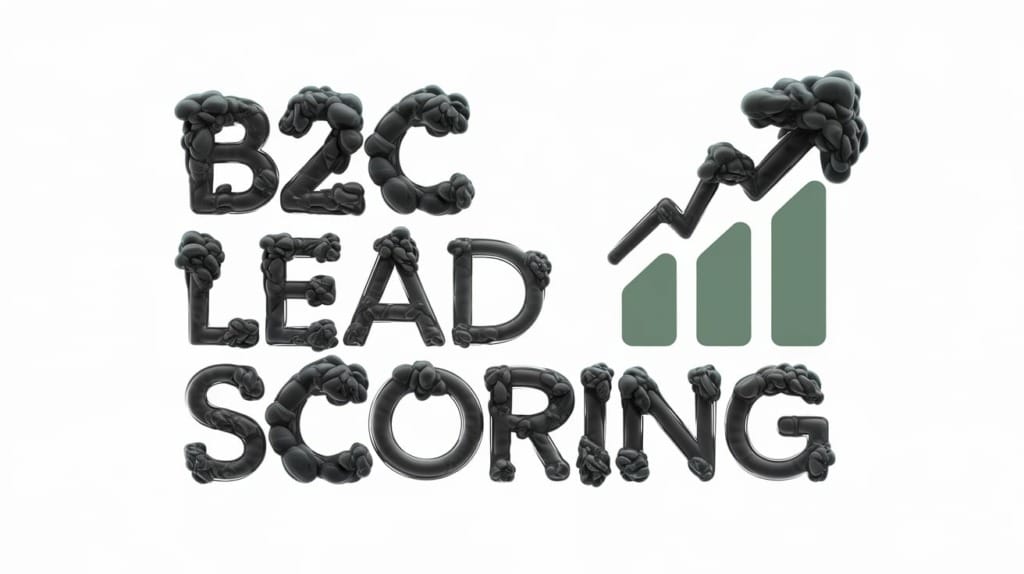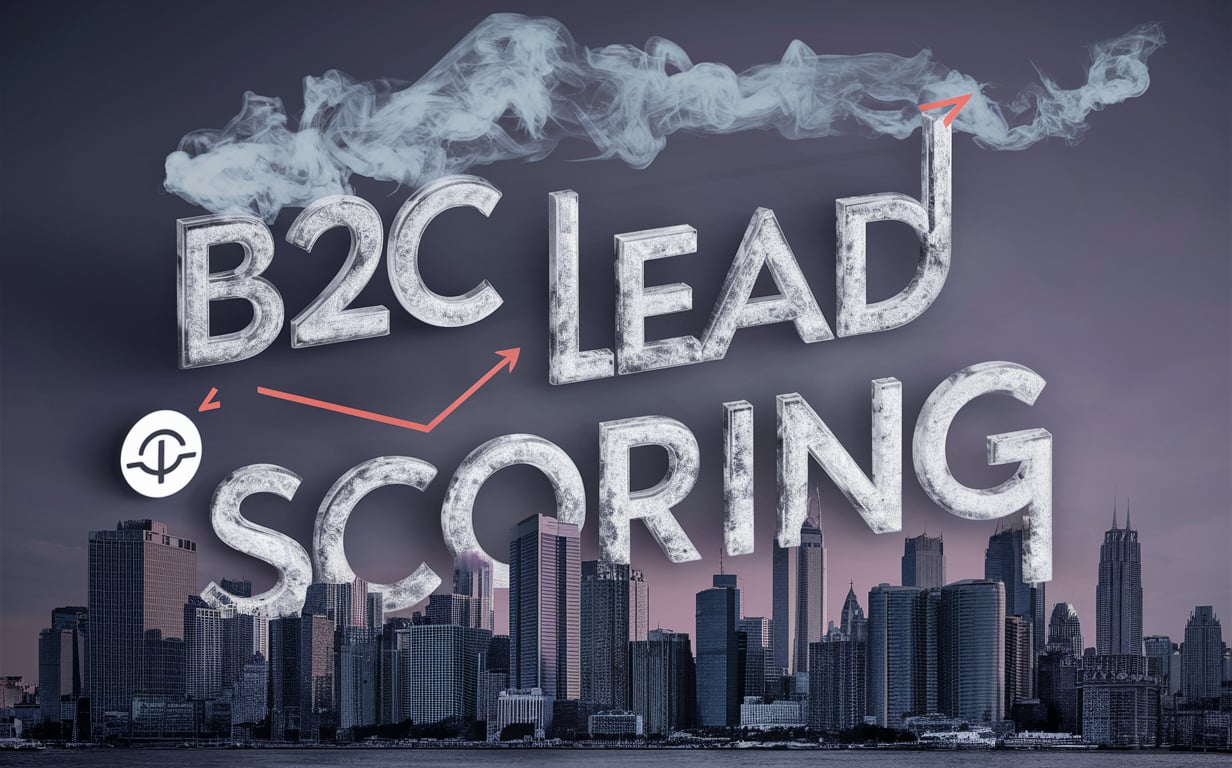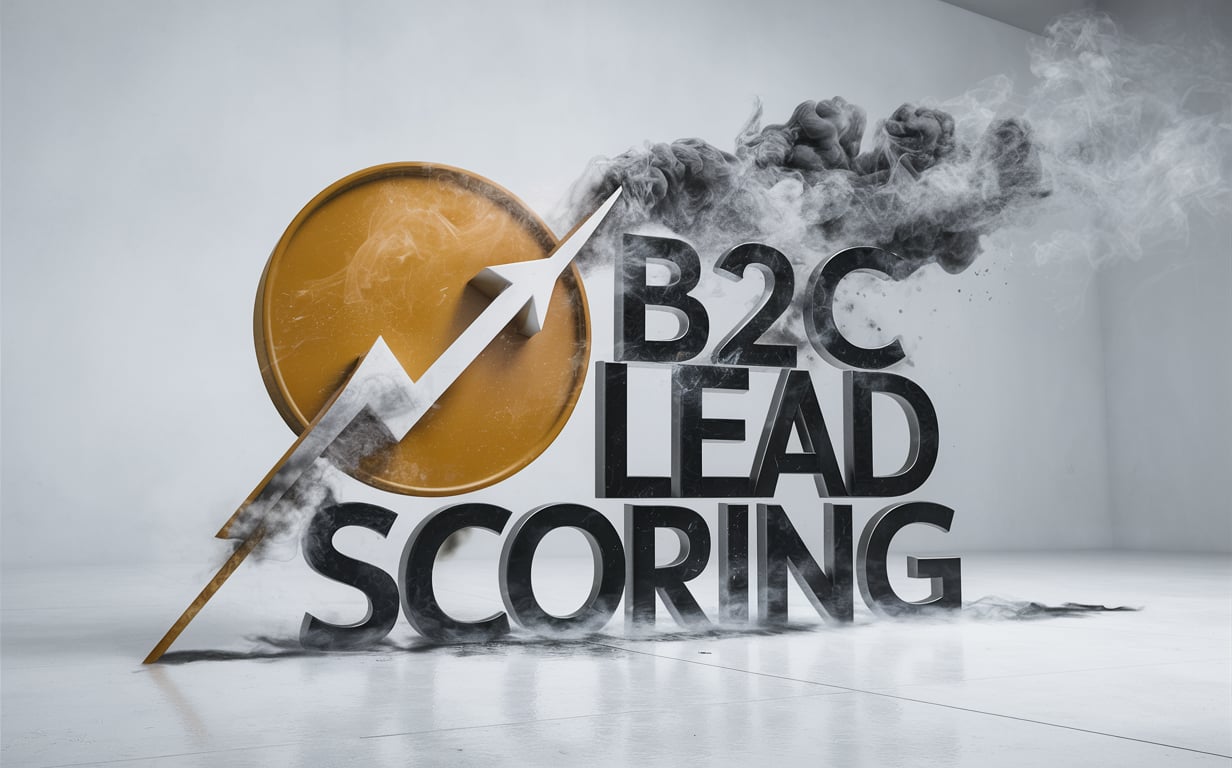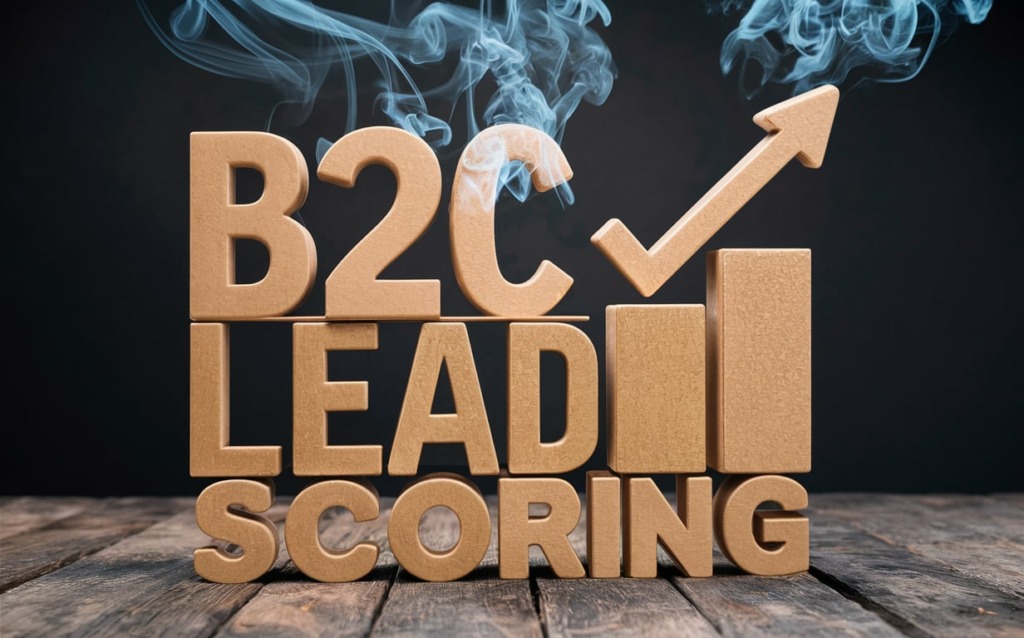What is B2C Lead Scoring?
If you’re like most B2C marketers, you live and breathe leads. You know that leads are the lifeblood of your business. But not all leads are created equal. Turning every lead into a sales-ready opportunity is like trying to turn straw into gold. What if I told you lead scoring could be your modern day spin on Rumpelstiltskin’s mythical power? Okay, maybe that’s a bit dramatic, but stay with me!
Lead scoring can feel magical when done right. This simple yet powerful technique can help you prioritize and personalize your marketing to the leads that are most likely to convert. But before we get ahead of ourselves, let’s start with the basics.
What Is Lead Scoring Exactly?
Lead scoring is a methodology that uses data to rank your leads based on parameters like demographics, behaviors, and interests. This allows you to gauge, on a scale of 1 to 100, how sales-ready a lead is. Leads with higher scores are hotter and more likely to convert, while leads with lower scores may require more nurturing.
It’s like giving your leads a grade based on their potential value. A+ prospects go straight to the sales team. B- and C-tier prospects might need some extra email love first before they’re ready to chat.
How Lead Scoring Transforms Your Marketing
Okay, but why should you care about scoring your leads?
Here are 3 key benefits:
- Saves Time and Resources: Your sales team can focus on the ripest leads instead of wasting time on unqualified ones.
- Improves Conversion Rates: With better lead prioritization, you can boost conversions across the funnel.
- Enables Personalization: You can tailor messaging and offers based on a lead’s profile and behaviors.
It’s a triple threat to boost sales productivity, tighten your sales funnel, and exceed customer expectations through relevance.
Comparing B2B vs B2C Lead Scoring
While lead scoring isn’t new, B2C marketers are starting to realize its powers more than ever.
Historically, lead scoring has been viewed as exclusive to B2B scenarios. And for good reason – with long, complex sales cycles, B2B teams live and die by lead qualification. But here’s the thing: lead scoring can actually be more impactful for B2C enterprises.
Here are two key differences between B2B and B2C lead scoring:
Data Factors
B2B scores focus on firmographic data – industry, company size, tech stack, etc. B2C scores focus on demographic and behavioral data – age, location, interests, web/email engagement.
Score Complexity
B2B scores often involve multiple stakeholders. B2C scores come down to one individual’s actions. This makes signals easier to interpret.
While B2C cycles are shorter, competition is fierce. Personalized lead scoring enables you to rise above the noise. More reasons why B2C brands need to embrace scoring to pump up marketing ROI.
How B2C Lead Scoring Actually Works
The specific process varies, but lead scoring typically follows three core steps:
- Select criteria: First, determine which lead attributes and behaviors indicate conversion potential for your business. Common options include demographics, lead source, content downloads, email engagement, etc.
- Assign point values: Next, decide how many points to assign to each conversion factor. More predictive/desirable factors should earn higher scores.
- Set a threshold: Finally, define the lead score threshold above which a lead is considered sales-qualified. Leads above the line get prioritized for outreach.
And voilà! Now you can categorize and route leads based on objective scores calculated from historical data. Pretty nifty, right?
In summary, lead scoring is a data-smart way to identify and double down on your hottest prospects. This allows B2C enterprises to scale personalized marketing that feels like it came straight from Rumpelstiltskin’s gold-spinning wheel. But unlike poor old Rumpelstiltskin, the only thing you’ll be jumping out of is an overly crowded sales funnel!

Why Lead Scoring is Crucial for B2C Companies
We covered the logistics of how lead scoring works. Now let’s get into why it’s so critical for B2C success.
Put simply, lead scoring helps you focus time and resources on the highest potential customers. This allows you to boost conversions and accelerate revenue growth.
Here are 3 reasons lead scoring is a must for B2C brands today:
1. Prioritizing Leads and Sales Efforts
Let’s face it – not every lead is ready to whip out their credit card and buy from you today. In fact, most leads require nurturing across weeks or months before they convert.
But here’s the kicker – studies show that only 2-5% of leads typically become customers. Yikes! That’s a ton of time and money spent chasing dead ends.
Lead scoring fixes this by helping you identify the “hot” leads likeliest to convert now. Rather than treat every lead equally, you can tier and prioritize them.
For example, you could categorize leads as:
- Tier 1 (Score 75-100) – Hot lead! Schedule sales call ASAP
- Tier 2 (Score 50-75) – Warm lead. Nurture first before sales call.
- Tier 3 (Score 0-50) – Cold lead. Put on backburner for now.
Now your sales reps don’t waste time calling uninterested leads. They can focus on hot, sales-ready leads first – and your team’s productivity skyrockets!
2. Personalizing Experiences for the Likeliest Buyers
Beyond prioritizing, lead scoring enables you to get hyper-personal with your marketing.
You can segment your audience based on their lead score bracket. Then, tailor content and offers specifically for each tier.
For example, you could:
- Send high-value content to engage cold leads
- Offer a promo code to warm leads if they take a desired action
- Make personalized product recommendations to hot leads
When you combine lead scoring with behavioral data and machine learning, the customization possibilities are endless.
3. Aligning Sales and Marketing Teams
Misalignment between sales and marketing is like a wedge being driven into your funnel. Lead scoring helps remove the wedge and gets both teams rowing in sync.
Sales needs a steady stream of qualified, sales-ready leads. Meanwhile, marketing wants to prove their programs deliver real pipeline impact.
Lead scoring creates a common language between the teams. When marketing nurtures leads to hit a shared scoring threshold, that “leveling up” moment builds trust on both sides.
Suddenly, sales has visibility into the value marketing provides. And marketing sees precisely how scoring guides better lead routing and sales outcomes.
In summary, lead scoring is mission-critical for B2C brands looking to boost conversions, personalize at scale, and align revenue teams. Lead scoring brings order to the chaotic, competitive world of B2C marketing.
Methods of Calculating B2C Lead Scores
When it comes to calculating lead scores, you’ve got options. The two main methods are:
- Rule-Based Lead Scoring
- Predictive Lead Scoring
Both can work wonders, but they each have pros and cons. Let’s break them down so you can decide what fits best.
Rule-Based Lead Scoring Models
Rule-based lead scoring is the OG method. It involves manually defining the criteria and point values that make up your scoring model.
Here’s how it works:
Pick Your Scoring Criteria
First, you handpick the attributes and behaviors to track for scoring, like:
- Demographic data
- Lead source
- Content downloads
- Form fills
- Webpage visits
- Email opens/clicks
- Etc.
Decide which factors indicate buyer readiness based on your historical conversion data and knowledge of your customers.
Assign Point Values
Next, determine the point values for each conversion factor you selected.
Actions strongly correlated with conversion should earn higher scores. For example:
- Visited pricing page: +15 points
- Opened targeted email: +10 points
- Clicked on ad: +5 points
You get the idea. Make sure point values align with the significance of each event.
Define Your Threshold
Finally, establish a threshold lead score above which a lead is considered “sales qualified” and ready for outreach.
For example, you might set the threshold at 50 points. So leads with 50+ points get handed off while those below 50 still need nurturing.
Test and Optimize
Don’t set and forget! Continuously test and tweak your criteria and point values to improve model accuracy over time.
That covers the basics of building a rule-based lead scoring model. While manual, it’s relatively straightforward for B2C brands to implement. You just need clear conversion data.
But it does come with some downsides…
Potential Cons of Rule-Based Lead Scoring:
- Subjective – You choose the criteria based on gut feel and experience.
- Labor intensive – Developing, managing and optimizing the model requires heavy human effort.
- Prone to bias – Models can reflect personal biases if not carefully tested.
- Not adaptive – The model only improves if you manually tweak it.
That’s where predictive lead scoring comes in…
Predictive Lead Scoring with AI/ML
Predictive lead scoring eliminates much of the guesswork involved with rule-based models. It leverages machine learning algorithms to determine which factors have the biggest correlation to lead conversion.
Here’s a high-level look at how it works:
- Feed historical lead data into a machine learning model.
- The algorithm analyzes the data to identify the attributes of leads that converted vs those that did not.
- It determines the criteria most predictive of conversion for your business.
- The algorithm calculates a lead score for each individual lead based on their match to these key attributes.
Voilà – no manual criteria selection needed! The machine learning model does the heavy lifting to create a tailored lead scoring framework specific to your business.
This automated approach has several benefits:
More accurate – By analyzing thousands of data points, predictive models are often more precise than human-crafted ones.
Adapts automatically – Models continue optimizing as you feed in new lead data over time. No ongoing manual tweaking needed.
Finds unseen patterns – Machine learning can uncover subtle correlations between attributes and conversion that humans would likely miss.
Scales easier – Once the initial model is built, it takes minimal effort to score new leads vs rule-based models.
Clearly, predictive lead scoring offers next-level intelligence compared to manual models. But AI/ML isn’t some magic wand you can just wave to enable it. You need a few foundations in place first.
Key Requirements for Predictive Lead Scoring
To leverage predictive scoring, you’ll need:
- Clean, extensive lead data – The algorithm needs sufficient historical conversion data to find meaningful patterns. Garbage in, garbage out.
- Lead enrichment data – Incorporate external demographic, interest, and other data to enhance model accuracy and depth.
- Powerful ML capabilities – The system must include robust machine learning algorithms tailored to lead scoring. Black box models won’t provide insights.
- Deployable – Scores are only useful if you can actually integrate and route them within your marketing and sales stack.
- Privacy conscious – Any use of external consumer data must be ethically sourced and stewarded.
If you have these foundational elements, predictive lead scoring can take your B2C marketing to the next level. For smaller brands lacking data resources, rule-based scoring is still an impactful place to start.
Whichever route you choose, implementing lead scoring is a must to cut through today’s B2C noise and hyper-target your dream customers. Lead scoring guides the way.

Using Lead Scores to Optimize B2C Marketing
You did it. You implemented a lead scoring model. Pat yourself on the back real quick.
…
Okay, back to business. Now it’s time to put those scores into action!
Here are 4 ways to leverage lead scoring and take your B2C marketing to the next level:
1. Lead Ranking and Suppression
One of the simplest but most impactful applications of lead scoring is lead prioritization.
You can rank your leads in descending order based on their scores. Then only focus sales and marketing efforts on leads above a chosen threshold.
For example, you could:
- Prioritize outreach to leads scoring 75+
- Remove leads scoring below 30 from active nurturing
- Route leads scoring 50-75 into targeted email campaigns
Suppressing low scoring leads from outreach helps ensure you don’t waste resources on unqualified contacts. Plus, your reps can better focus on hot leads with each batch.
2. Customized Promotions and Discounts
Beyond priority routing, you can get creative with tailored promotions based on lead score brackets.
For example:
- Leads 30-50: 10% off discount code for taking a desired action
- Leads 50-75: 20% off discount code
- Leads 75-100: 30% off discount code
Higher scoring leads logically have higher conversion potential. Offering escalating discounts incentivizes leads to level up their engagement and earn rewards in return.
This type of personalized promotion strategy works across channels – email, on-site messaging, text, social media ads, and more. Get creative!
3. Dynamic Website and Ad Personalization
Your website and ads are prime real estate to serve dynamic experiences based on lead scores.
You can tailor content and product recommendations for each lead score segment. Show cold leads more introductory materials. Show hot leads premium offerings and special deals.
You can even optimize ads this way. Display different versions of ad copy and creatives to different scoring brackets. This will increase relevance and performance.
When done right, visitors feel like your brand “gets” them because experiences are aligned to their buyer stage. Pretty awesome.
4. Sales Lead Routing and Distribution
Who receives each sales lead on your team is an important decision. You can optimize lead routing based on tiered lead scores.
For example:
- Leads <30: Receive automated nurture only
- Leads 30-50: Route to junior sales reps
- Leads 50-75: Route to senior sales reps
- Leads 75+: Route to A-team reps for urgent outreach
This allows you to align sales resources to lead potential. Top reps get to focus on the juiciest opportunities.
For teams that outsource lead follow-ups, the same rules apply. Route higher scoring leads to higher-performing partners first.
You can even dynamically set appointments and meeting links in your CRM based on lead scores. This makes the handoff seamless.
And there you have it – four ways to turn lead scoring into B2C marketing ROI. From segmentation to personalization to lead routing and beyond, the possibilities are endless.
Let’s recap the key benefits:
- Focus resources on higher converting leads
- Offer tailored promotions and discounts
- Provide dynamic website experiences
- Enable data-driven lead-to-rep routing
Now stop reading and start scoring some leads! Just don’t forget to measure impact and continue optimizing your models over time.
Best Practices for Ongoing Success
Rolling out lead scoring is a big win. But don’t spike the football just yet.
To continually improve results, you need to nurture your scoring models. Here are 4 best practices to make lead scoring work for the long run:
1. Continually Test and Optimize Your Model
Lead scoring isn’t a “set it and forget it” tactic. Like any marketing initiative, you need to monitor performance and tweak over time.
Here are some ways to test and optimize:
Watch for overscoring trends – If many low-value leads are scoring high, revisit criteria weights.
Analyze conversion rates – Assess conversion rates for each score bracket. Tweak criteria if needed to lift rates.
Review outliers – Look for odd blips like high-value conversions from low scores. Determine if data errors or a sweet spot.
Check sales feedback – Ask reps if lead scores align with their experience. Incorporate insights into model.
A/B test – Build multiple versions of your scoring model and compare conversion rates. Roll out the top preformer.
Update regularly – Set a cadence to review and update your scoring framework. Quarterly or bi-annually works for most brands.
Optimizing is especially important if you take a rules-based approach. But even predictive models need TLC – garage in, garbage out.
2. Maintain Updated Customer and Lead Data
The lifeblood of lead scoring is current, comprehensive data. Be relentless about capturing up-to-date info on both new leads and existing customers.
Fix data quality issues – Standardize formats, fill gaps, de-dupe, and fix inaccuracies in your data.
Encourage form fills – Use pop-ups and offer opt-in incentives to maximize data capture.
Track engagement – Install tracking across channels to monitor behaviors and engagement.
Build lead profiles – Enrich with demographic, interest, social, and contact data.
Tag outcomes – Denote won/lost status, churned customers, repeat purchases, etc.
Feed it back – Continuously feed updated data back into your lead scoring models.
Robust, quality data ensures your scores remain calibrated as new leads come in. This powers ongoing optimization.
3. Ensure Responsible Use of Consumer Data
While external data can improve model performance, ethical use is an absolute must.
Thoroughly vet partners – Only work with reputable data vendors with guaranteed consent policies.
Anonymize data – Collect, process, and store data separately from individual identifiers.
Be transparent – Disclose you use lead enrichment and how it benefits customers.
Give choices – Allow customers to opt-out of data collection/sharing.
Limit access – Only allow essential staff to access sensitive lead data if needed.
Secure tightly – Encrypt data end-to-end and implement access controls.
With consumer privacy top of mind, you can still leverage data safely to personalize experiences.
4. Compare Predictive vs. Rules-Based Scoring
Should you take a predictive or rules-based approach? Why not test both!
Run an A/B experiment with a predictive and rules-based version of your model. Hold all else constant and see which methodology results in higher conversion rates.
This allows you to validate that predictive scoring delivers on its accuracy promises. Or, that your in-house expertise trumps machines for now.
Over time you can double down on the better preforming method or blend both together.
Lead scoring excellence combines art and science. While leveraging automation, you need to stay hands-on. Test assumptions, inspect data, listen to feedback, and guide models in the right direction.
When done right, lead scoring pumps rocket fuel into your customer acquisition and drives big wins for marketing and sales. Onwards and upwards!

B2C Lead Scoring Metrics to Track
Like any marketing initiative, you need to monitor the right metrics to gauge the impact of lead scoring.
Here are 3 key performance indicators to track:
1. Lead-to-Customer Conversion Rate
The ultimate proof of effective lead scoring is lifting conversion rates. Compare your lead-to-customer percentages before vs after implementing scoring.
Ideally, you should see conversion rates increase over time for higher score brackets. This indicates your model is accurately identifying and prioritizing hot leads.
A few metrics to monitor:
- Overall conversion rate
- Conversion rates by lead score segment
- Conversion rates by lead source
- Conversion rates by marketing campaign
Optimizing your scoring model and nurturing to increase these conversion metrics is the name of the game.
2. Average Deal Size for High vs Low Scores
If your lead scoring model is working, your sales team should close larger average deal sizes from high scoring leads.
Analyze the average order value or LTV for customers acquired from different lead score tiers.
For example:
- Leads scored 0-25: Avg deal size $250
- Leads scored 25-50: Avg deal size $500
- Leads scored 50-75: Avg deal size $750
- Leads scored 75-100: Avg deal size $1,000
Bigger deal sizes from higher scoring leads indicate your model accurately predicts customer value. If lower scores outperform, revisit your criteria.
3. Sales Rep Performance by Score Bracket
Look at how individual sales reps perform when allocated leads from different scoring segments.
For example, analyze each rep’s:
- Lead-to-customer conversion rate
- Average deal size
- Total revenue generated
Ideally your top reps will convert high-scoring leads at the highest rates. This validates that high scores represent hot leads.
Conversely, if lower-tier reps outperform on high scores, your criteria may be off. Their success could just come from greater effort, not necessarily lead quality.
Review this metric across your sales team. It will reveal if you need to refine criteria or rep training on handling ideal prospects.
Lead Scoring Lifts Results
Approaching lead scoring with a test-and-learn mindset is key. Measure these conversion and revenue metrics diligently. Let data guide your model optimization and messaging strategies.
When done right, the numbers don’t lie. Lead scoring provides a clear growth edge in the chaotic world of B2C marketing and sales. Just stay diligent with adoption and impact will follow.

Key Takeaways
Lead scoring is a must for data-driven B2C marketing today. Here are the core concepts to remember:
- Lead scoring assigns points to each lead based on their potential value. This allows you to prioritize and personalize outreach.
- While historically more common in B2B, lead scoring offers huge upside for B2C brands competing for consumers.
- Rule-based models involve manually selecting criteria and point values. Predictive models use machine learning to determine ideal scoring algorithms.
- Lead scores power optimization across marketing channels – websites, email, ads, customer journeys and more.
- Monitor conversion rates, deal sizes, and rep performance closely to continuously improve your scoring framework.
- Lead scoring transforms chaotic B2C funnels into optimized machines for acquiring and retaining ideal customers.
Prioritizing the right consumers is the name of the game. Dial up data-driven scoring and watch your profits soar.
Frequently Asked Questions
What is B2C lead scoring?
B2C lead scoring is the process of assigning points to consumer leads based on attributes indicating their potential value. This allows you to identify and focus on hot leads most likely to convert into customers.
How is B2C lead scoring different from B2B?
B2C scoring is based more on demographics and behaviors vs firmographics. It focuses on individuals rather than group consensus. Shorter cycles also allow faster optimization.
What data is used for B2C lead scoring?
Typically a combination of first-party lead/customer data with third-party demographic and consumer data for enrichment. Common attributes include age, location, interests, web engagement, past purchases, etc.
What are the main methods for calculating scores?
Rule-based models manually define criteria and values. Predictive models use machine learning algorithms to determine the optimal scoring framework.
How can you use lead scores to improve marketing?
Lead scoring enables segmentation, personalized experiences, promotion tailoring, lead routing, sales prioritization, and more.
What metrics indicate effective lead scoring?
Key indicators are conversion rate lift, higher deal sizes from top scores, and individual sales rep performance by score bracket.
How should you optimize lead scoring over time?
Continually test and update your model. Maintain clean,current data. Review results and rep feedback. Follow privacy best practices.
What tools do you need for lead scoring?
Typical solutions include CRM, marketing automation, predictive analytics, and optionally third-party data enrichment and model building tools.
Is lead scoring worth the effort for B2C companies?
Absolutely – the personalized marketing and optimized conversion funnel lead scoring enables is well worth the investment for most B2C brands.

